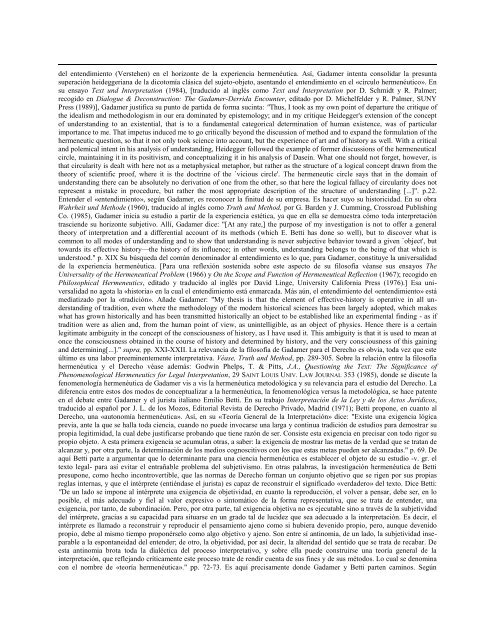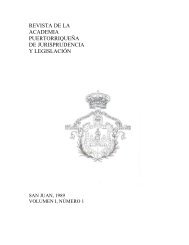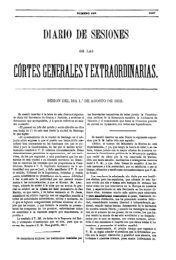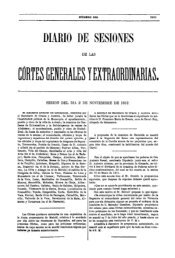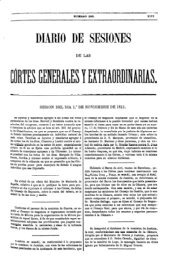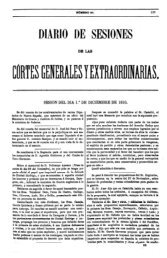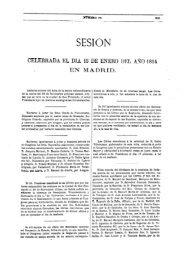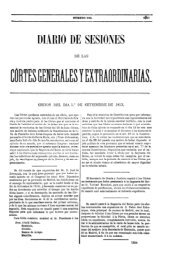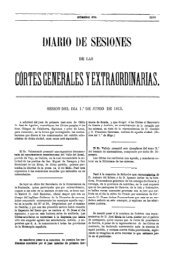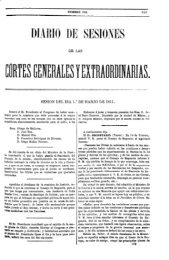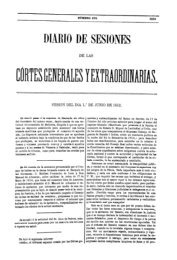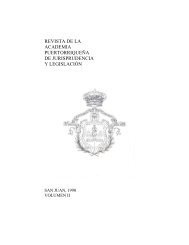<strong>de</strong>l entendimiento (Verstehen) en el horizonte <strong>de</strong> la experiencia hermenéutica. Así, Gadamer intenta consolidar la presuntasuperación hei<strong>de</strong>ggeriana <strong>de</strong> la dicotomía clásica <strong>de</strong>l sujeto-objeto, asentando el entendimiento en el «círculo hermenéutico». Ensu ensayo Text und Interpretation (1984), [traducido al inglés como Text and Interpretation por D. Schmidt y R. Palmer;recogido en Dialogue & Deconstruction: The Gadamer-Derrida Encounter, editado por D. Michelfel<strong>de</strong>r y R. Palmer, SUNYPress (1989)], Gadamer justifica su punto <strong>de</strong> partida <strong>de</strong> forma sucinta: "Thus, I took as my own point of <strong>de</strong>parture the critique ofthe i<strong>de</strong>alism and methodologism in our era dominated by epistemology; and in my critique Hei<strong>de</strong>gger's extension of the conceptof un<strong>de</strong>rstanding to an existential, that is to a fundamental categorical <strong>de</strong>termination of human existence, was of particularimportance to me. That impetus induced me to go critically beyond the discussion of method and to expand the formulation of thehermeneutic question, so that it not only took science into account, but the experience of art and of history as well. With a criticaland polemical intent in his analysis of un<strong>de</strong>rstanding, Hei<strong>de</strong>gger followed the example of former discussions of the hermeneuticalcircle, maintaining it in its positivism, and conceptualizing it in his analysis of Dasein. What one should not forget, however, isthat circularity is <strong>de</strong>alt with here not as a metaphysical metaphor, but rather as the structure of a logical concept drawn from thetheory of scientific proof, where it is the doctrine of the `vicious circle'. The hermeneutic circle says that in the domain ofun<strong>de</strong>rstanding there can be absolutely no <strong>de</strong>rivation of one from the other, so that here the logical fallacy of circularity does notrepresent a mistake in procedure, but rather the most appropriate <strong>de</strong>scription of the structure of un<strong>de</strong>rstanding [...]". p.22.Enten<strong>de</strong>r el «entendimiento», según Gadamer, es reconocer la finitud <strong>de</strong> su empresa. Es hacer suyo su historicidad. En su obraWahrheit und Metho<strong>de</strong> (1960), traducido al inglés como Truth and Method, por G. Bar<strong>de</strong>n y J. Cumming, Crossroad PublishingCo. (1985), Gadamer inicia su estudio a partir <strong>de</strong> la experiencia estética, ya que en ella se <strong>de</strong>muestra cómo toda interpretacióntrascien<strong>de</strong> su horizonte subjetivo. Allí, Gadamer dice: "[At any rate,] the purpose of my investigation is not to offer a generaltheory of interpretation and a differential account of its methods (which E. Betti has done so well), but to discover what iscommon to all mo<strong>de</strong>s of un<strong>de</strong>rstanding and to show that un<strong>de</strong>rstanding is never subjective behavior toward a given `object', buttowards its effective history—the history of its influence; in other words, un<strong>de</strong>rstanding belongs to the being of that which isun<strong>de</strong>rstood." p. XIX Su búsqueda <strong>de</strong>l común <strong>de</strong>nominador al entendimiento es lo que, para Gadamer, constituye la universalidad<strong>de</strong> la experiencia hermenéutica. [Para una reflexión sostenida sobre este aspecto <strong>de</strong> su filosofía véanse sus ensayos TheUniversality of the Hermeneutical Problem (1966) y On the Scope and Function of Hermeneutical Reflection (1967); recogido enPhilosophical Hermeneutics, editado y traducido al inglés por David Linge, University California Press (1976).] Esa universalidadno agota la «historia» en la cual el entendimiento está enmarcada. Más aún, el entendimiento <strong>de</strong>l «entendimiento» estámediatizado por la «tradición». Aña<strong>de</strong> Gadamer: "My thesis is that the element of effective-history is operative in all un<strong>de</strong>rstandingof tradition, even where the methodology of the mo<strong>de</strong>rn historical sciences has been largely adopted, which makeswhat has grown historically and has been transmitted historically an object to be established like an experimental finding - as iftradition were as alien and, from the human point of view, as unintelligible, as an object of physics. Hence there is a certainlegitimate ambiguity in the concept of the consciousness of history, as I have used it. This ambiguity is that it is used to mean atonce the consciousness obtained in the course of history and <strong>de</strong>termined by history, and the very consciousness of this gainingand <strong>de</strong>termining[...]." supra, pp. XXI-XXII. La relevancia <strong>de</strong> la filosofía <strong>de</strong> Gadamer para el Derecho es obvia, toda vez que esteúltimo es una labor preeminentemente interpretativa. Véase, Truth and Method, pp. 289-305. Sobre la relación entre la filosofíahermenéutica y el Derecho véase a<strong>de</strong>más: Godwin Phelps, T. & Pitts, J.A., Questioning the Text: The Significance ofPhenomenological Hermeneutics for Legal Interpretation, 29 SAINT LOUIS UNIV. LAW JOURNAL 353 (1985), don<strong>de</strong> se discute lafenomenología hermenéutica <strong>de</strong> Gadamer vis a vis la hermenéutica metodológica y su relevancia para el estudio <strong>de</strong>l Derecho. Ladiferencia entre estos dos modos <strong>de</strong> conceptualizar a la hermenéutica, la fenomenológica versus la metodológica, se hace patenteen el <strong>de</strong>bate entre Gadamer y el jurista italiano Emilio Betti. En su trabajo Interpretación <strong>de</strong> la Ley y <strong>de</strong> los Actos Jurídicos,traducido al español por J. L. <strong>de</strong> los Mozos, Editorial <strong>Revista</strong> <strong>de</strong> Derecho Privado, Madrid (1971); Betti propone, en cuanto alDerecho, una «autonomía hermenéutica». Así, en su «Teoría General <strong>de</strong> la Interpretación» dice: "Existe una exigencia lógicaprevia, ante la que se halla toda ciencia, cuando no pue<strong>de</strong> invocarse una larga y continua tradición <strong>de</strong> estudios para <strong>de</strong>mostrar supropia legitimidad, la cual <strong>de</strong>be justificarse probando que tiene razón <strong>de</strong> ser. Consiste esta exigencia en precisar con todo rigor supropio objeto. A esta primera exigencia se acumulan otras, a saber: la exigencia <strong>de</strong> mostrar las metas <strong>de</strong> la verdad que se tratan <strong>de</strong>alcanzar y, por otra parte, la <strong>de</strong>terminación <strong>de</strong> los medios cognoscitivos con los que estas metas pue<strong>de</strong>n ser alcanzadas." p. 69. Deaquí Betti parte a argumentar que lo <strong>de</strong>terminante para una ciencia hermenéutica es establecer el objeto <strong>de</strong> su estudio -v. gr. eltexto legal- para así evitar el entrañable problema <strong>de</strong>l subjetivismo. En otras palabras, la investigación hermenéutica <strong>de</strong> Bettipresupone, como hecho incontrovertible, que las normas <strong>de</strong> Derecho forman un conjunto objetivo que se rigen por sus propiasreglas internas, y que el intérprete (entiéndase el jurista) es capaz <strong>de</strong> reconstruir el significado «verda<strong>de</strong>ro» <strong>de</strong>l texto. Dice Betti:"De un lado se impone al intérprete una exigencia <strong>de</strong> objetividad, en cuanto la reproducción, el volver a pensar, <strong>de</strong>be ser, en loposible, el más a<strong>de</strong>cuado y fiel al valor expresivo o sintomático <strong>de</strong> la forma representativa, que se trata <strong>de</strong> enten<strong>de</strong>r, unaexigencia, por tanto, <strong>de</strong> subordinación. Pero, por otra parte, tal exigencia objetiva no es ejecutable sino a través <strong>de</strong> la subjetividad<strong>de</strong>l intérprete, gracias a su capacidad para situarse en un grado tal <strong>de</strong> luci<strong>de</strong>z que sea a<strong>de</strong>cuado a la interpretación. Es <strong>de</strong>cir, elintérprete es llamado a reconstruir y reproducir el pensamiento ajeno como si hubiera <strong>de</strong>venido propio, pero, aunque <strong>de</strong>venidopropio, <strong>de</strong>be al mismo tiempo proponérselo como algo objetivo y ajeno. Son entre sí antinomia, <strong>de</strong> un lado, la subjetividad inseparablea la espontaneidad <strong>de</strong>l enten<strong>de</strong>r; <strong>de</strong> otro, la objetividad, por así <strong>de</strong>cir, la alteridad <strong>de</strong>l sentido que se trata <strong>de</strong> recabar. Deesta antinomia brota toda la dialéctica <strong>de</strong>l proceso interpretativo, y sobre ella pue<strong>de</strong> construirse una teoría general <strong>de</strong> lainterpretación, que reflejando críticamente este proceso trate <strong>de</strong> rendir cuenta <strong>de</strong> sus fines y <strong>de</strong> sus métodos. Lo cual se <strong>de</strong>nominacon el nombre <strong>de</strong> «teoría hermenéutica»." pp. 72-73. Es aquí precisamente don<strong>de</strong> Gadamer y Betti parten caminos. Según
VIIIFuerza: Po<strong>de</strong>r. La Fuerza indiscriminada, o sea, la fuerza previa a su ejercicio, es laviolencia que prece<strong>de</strong> todo juicio valorativo. Es, en otras palabras, la violencia que constituyeaquello que algunos llaman la moral. 22 Sin embargo, todo acceso a esa fuerza está mediatizadaGadamer, aun cuando Betti reconoce la centralidad <strong>de</strong>l acto interpretativo, su teoría todavía respon<strong>de</strong> a un psicologismo<strong>de</strong>cimonónico, toda vez que es el intérprete quien tiene que reconstruir el «sentido» <strong>de</strong>l texto - el mens auctoris, si se quiere—mediante la objetificación <strong>de</strong>l mismo. Para la reacción <strong>de</strong> Gadamer a la posición <strong>de</strong> Betti, véase, Truth and Method, SupplementI: "Hermeneutics and Historicism", pp. 460-491. George Wright ha resumido admirablemente los contornos <strong>de</strong>l <strong>de</strong>bate en suartículo On a General Theory of Interpretation: The Betti-Gadamer Dispute in Legal Hermeneutics; 32 The American Journal ofJurispru<strong>de</strong>nce 191 (1987). No obstante sus diferencias, las posiciones <strong>de</strong> Gadamer y Betti concuerdan en que toda interpretación,ya sea <strong>de</strong> un texto literario o jurídico, respon<strong>de</strong> <strong>de</strong> un modo u otro a la «tradición» en que se encuentra. Sobre la «tradición», y suinjerencia en el acto interpretativo, dice Gadamer: "The totality of meaning that has to be un<strong>de</strong>rstood in history or tradition isnever the meaning of the totality of history. The danger of Docetism seems banished when historical tradition is not conceived asan object of historical knowledge or of philosophical conception, but as an effective moment of one's own being. The finite natureof one's own un<strong>de</strong>rstanding is the manner in which reality, resistance, the absurd, and the unintelligible assert themselves. Ifone takes this finiteness seriously, then one must also take the reality of history seriously." Supra, p. XXIII. Betti, a su vez, dice:"Hay que rechazar, ante todo, como fruto <strong>de</strong> la inercia mental, la habitual <strong>de</strong>limitación <strong>de</strong> competencias, por lo que se estima queel estudio <strong>de</strong> un Derecho en vigor requiere solamente actitu<strong>de</strong>s dogmáticas y, a la inversa, que el estudio <strong>de</strong>l Derecho histórico,no vigente, solamente actitu<strong>de</strong>s históricas. El error <strong>de</strong> esta interpretación se advierte ya en la interpretación <strong>de</strong> la ley: don<strong>de</strong> laexégesis <strong>de</strong> toda la fórmula legislativa no pue<strong>de</strong> nunca prescindir <strong>de</strong>l elemento histórico, ya que el encuentro <strong>de</strong>l intérprete con eltexto legal no es nunca un contacto «directo» que prescinda <strong>de</strong> la mediación <strong>de</strong> anillos intermedios. El encuentro presupone en elintérprete, como en los miembros <strong>de</strong> la comunidad, una educación a<strong>de</strong>cuada y se opera a través <strong>de</strong> la tradición <strong>de</strong> lajurispru<strong>de</strong>ncia, que contribuye a promover en los juristas la necesaria formación mental. Más aún, teniendo en cuenta que lasinstituciones y la forma <strong>de</strong> expresarse jurídicamente tienen el estilo <strong>de</strong> un lenguaje técnico, es más necesaria una preparaciónhistórica en el que es llamado a enten<strong>de</strong>rlas. Precisamente, viviendo en la tradición <strong>de</strong> la jurispru<strong>de</strong>ncia, pue<strong>de</strong>n los juristasrealizar la continuidad <strong>de</strong> la vida <strong>de</strong>l Derecho, fundir en armónica coherencia los datos con las nuevas adquisiciones, advertir losnexos que ligan la letra <strong>de</strong> la ley al pensamiento que traducen. Por eso, el lenguaje <strong>de</strong> una ley en vigor no pue<strong>de</strong> ser rectamenteentendido, cuando se separa <strong>de</strong> sus prece<strong>de</strong>ntes históricos, por consi<strong>de</strong>rarla en cualquier modo autosuficiente, en función <strong>de</strong> lamateria disciplinada. La letra <strong>de</strong> la ley no es más que un entramado, <strong>de</strong>stinado a reanimarse y a iluminarse, <strong>de</strong> un lado, alcontacto con la vida social; <strong>de</strong> otro, con la luz <strong>de</strong> la tradición [...]". supra. p.77. La dificultad filosófica que plantea la posición <strong>de</strong>Gadamer, por no <strong>de</strong>cir la <strong>de</strong> Betti, es que, por un lado, se concibe a la «tradición» como una categoría que encuadra al«entendimiento» sin especificar precisamente en qué consiste. Si esa «tradición» es homogénea o heterogénea, etc. Habermas hacriticado, correctamente a mi enten<strong>de</strong>r, el carácter absolutista que Gadamer le atribuye a la «tradición», obviando a nombre <strong>de</strong>ldiálogo la necesidad <strong>de</strong> la I<strong>de</strong>ologiekritik. Gadamer, claro, arguye que aun la crítica i<strong>de</strong>ológica se encuentra enmarcada por suhorizonte histórico. Para una discusión sobre el <strong>de</strong>bate entre Habermas y Gadamer, véase McCarthy, T.; The Critical Theory ofJürgen Habermas, MIT Press, Cambridge (1978). pp. 162-192. Por otro lado, el reclamo <strong>de</strong> la universalidad <strong>de</strong> la experienciahermenéutica rebota contra su también reclamada finitud. Véase Dallmayr, F.R.; Hermeneutics and Deconstruction: Gadamerand Derrida in Dialogue, recogido en Dialogue & Deconstruction, supra. pp. 75-92. Para una reflexión general sobre la filosofía<strong>de</strong> Gadamer, véase a<strong>de</strong>más, Habermas, J.; H-G. Gadamer: Urbanizing <strong>de</strong> Hei<strong>de</strong>ggerian Province (1979), recogido enPhilosophical-Political Profiles, traducido al inglés por F.G. Lawrence, MIT Press, Cambridge (1983). pp. 191-199.22Benjamín comienza su ensayo A Critique of Violence con las siguientes aseveraciones: "The task of a critique of violence canbe summarized as that of expounding its relation to law and justice. For a cause, however effective, becomes violent, in theprecise sense of the word, only when it bears on moral issues. The sphere of these issues is <strong>de</strong>fined by the concept of law andjustice [...]." p. 277. (La palabra «Gewalt» significa en alemán «violencia» tanto como «autoridad», «fuerza legítima», etc. ¿Hastaque punto, como bien y paradójicamente señala Derrida en su ensayo Force of Law, p. 927, esta traducción violenta el texto <strong>de</strong>Benjamin?) A partir <strong>de</strong> aquí, Benjamín proce<strong>de</strong> a hacer tres distinciones que enmarcan su «Kritik». Distingue, primeramente,entre la «violencia fundacional», que instituye a la Ley (die rechtsetzen<strong>de</strong> Gewalt), y la «violencia conservadora», que asegura lapermanencia <strong>de</strong> la Ley (die rechtserhalten<strong>de</strong> Gewalt). En segundo lugar, distingue entre la «violencia mítica», que vincula a latradición helénica, y que es una violencia fundadora, y la «violencia divina», que vincula a la tradición judaica y que es unaviolencia <strong>de</strong>structiva. Finalmente, distingue entre el «po<strong>de</strong>r» que asocia con la «violencia mítica», y la «justicia» que asocia conla «violencia divina». La diferencia fundamental, según Benjamín, entre la violencia «mítica» y la «divina» es una diferencia <strong>de</strong>fines y medios. La primera es un ejercicio <strong>de</strong>l po<strong>de</strong>r sobre la vida sin ningún propósito ulterior, mientras que la segunda es elpo<strong>de</strong>r absoluto sobre la vida, en aras <strong>de</strong> la vida misma. Dice: "[...] Mythical violence is bloody power over mere life for its ownsake, divine violence, pure power over all life for the sake of the living. The first <strong>de</strong>mands sacrifice, the second accepts it". p.297. Concluye su ensayo con la siguiente <strong>de</strong>claración: "Divine violence, which is the sign and seal but never the means of sacre<strong>de</strong>xecution, may be called sovereign violence." p. 300. En el «Post-Scriptum» a Force of Law, Derrida confronta este texto con la«solución final» <strong>de</strong> los nazis, y, hechas las salveda<strong>de</strong>s en cuanto a su contexto histórico, concluye que la ambigüedad <strong>de</strong>l textopermite interpretar el Holocausto como una instancia <strong>de</strong> esa «violencia soberana». Me parece que Derrida le conce<strong>de</strong> una
- Page 1 and 2:
REVISTA DE LA ACADEMIA PUERTORRIQUE
- Page 3:
2enardecerá, en vez de corregir, l
- Page 9 and 10:
través de la Ley, enardecerá, en
- Page 11 and 12:
MEDICINE AND BIOLOGY: HOW FAR CAN T
- Page 13:
unfair, in view of the total absenc
- Page 16 and 17:
CONTESTACIÓN AL DISCURSO DEL HON.
- Page 18 and 19:
la Oficina de Política sobre Cienc
- Page 20 and 21:
códigos de ética existentes y los
- Page 22 and 23:
REFORMING THE FEDERAL SENTENCING GU
- Page 24 and 25:
narcotics and firearms, they tend t
- Page 26 and 27:
Our faith in technology and plannin
- Page 28 and 29:
single, all-powerful judge”. 17 W
- Page 30 and 31:
CONTESTACIÓN AL DISCURSO DEL HON.
- Page 32 and 33:
3trafficking and gun-related offens
- Page 34 and 35:
5conduct which experience has shown
- Page 36 and 37:
2En este escrito trataré de establ
- Page 38 and 39:
4atender sus obligaciones económic
- Page 40 and 41:
6B. Juicio Público: Al igual que e
- Page 42 and 43:
8explicar la doctrina vigente. 47 A
- Page 44 and 45:
10tan serio disturbio emocional (
- Page 46 and 47:
12En Soto Ramos v. Superintendente
- Page 48 and 49:
14profesional y cómo ésta podría
- Page 50 and 51:
16Las implicaciones de esta exigenc
- Page 52 and 53:
18jurado. 116 Por otro lado, nuestr
- Page 54 and 55:
20forma rigurosa, de que la renunci
- Page 56 and 57:
22Tribunal Supremo ha seguido celos
- Page 58 and 59:
24protección es mayor que la que e
- Page 60 and 61:
264. Absuelto un acusado por determ
- Page 62 and 63:
28En Puerto Rico sólo cabe regular
- Page 64 and 65:
30B. Aplicación ex post facto de l
- Page 66 and 67:
32relación con el alcance 224 de l
- Page 68 and 69:
34se trata de una norma que comenz
- Page 70 and 71:
364) que la corroboración se relac
- Page 72 and 73:
38arresto. Bajo la Enmienda Cuarta,
- Page 74 and 75:
40razonable a la intimidad, no hay
- Page 76 and 77:
42Nuestra legislación permite la d
- Page 78 and 79: 44Derechos se dispone expresamente
- Page 80 and 81: 46Estados Unidos, adopta una posici
- Page 82 and 83: 2Aclarados esos puntos, coincido co
- Page 84 and 85: La verdad es que los principios con
- Page 86 and 87: EL DOLOR Y LA ANGUSTIA MENTALRamón
- Page 88 and 89: 3.7 8 9 10conocida y aceptada, hast
- Page 90 and 91: 5estímulo. Sin embargo, el punto e
- Page 92 and 93: 7de reconocimiento mundial, como ex
- Page 94 and 95: dice que éste no distingue entre e
- Page 96 and 97: 11dos meses y medio más tarde cuan
- Page 98 and 99: implicaciones negativas. Se debe de
- Page 100 and 101: 2naturaleza de los seres vivos, apl
- Page 102 and 103: 4de la clase dominante en la socied
- Page 104 and 105: 6su hora admitió ser identificado
- Page 106 and 107: 8cumpla la prestación que la norma
- Page 108 and 109: 10Encontramos la expresión todaví
- Page 110 and 111: 12La satisfacción de necesidades h
- Page 112 and 113: 14como aquí se propone, puede hace
- Page 114 and 115: LOS DERECHOS HUMANOS FRENTE AL ESTA
- Page 116 and 117: Como resultado, se ha llegado a un
- Page 118 and 119: Yugoslavia, Georgia, Azerbaiján, A
- Page 120 and 121: METASTESIS DE LA «RAZÓN» Y EL «
- Page 122 and 123: fue quizás el producto de esa mism
- Page 124 and 125: embargo, la corroboración de la ne
- Page 126 and 127: VICuando Hegel, en su Phänomenolog
- Page 130 and 131: por el poder, por las estructuras y
- Page 132 and 133: lo único que indica esta trasgresi
- Page 134 and 135: Legislativa enmendó la Ley 53 orig
- Page 136 and 137: Incluso, únicamente ofreció su t
- Page 138 and 139: Al llegar a la gobernación en 1965
- Page 140 and 141: Presidente del Tribunal Supremo y a
- Page 142 and 143: Lamentablemente, vivimos en una soc
- Page 144 and 145: 1. El que en todas las acciones rel
- Page 146 and 147: coordinación interagencial, con pa


